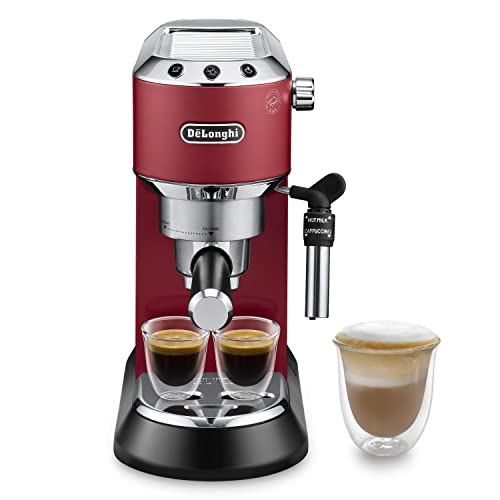What to Look For in a Commercial Espresso Machine
There are many things to consider when purchasing an espresso machine for commercial use. The kind of espresso machine that is right for your cafe will depend on the quantity, the intended use, and barista's abilities.
A double boiler system provides the ability to brew and steam simultaneously. This decreases the time it takes to recuperate between pulls. Proportional-integral-derivative (PID) temperature control manages on/off cycles for optimal boiler temperatures.
Productivity
A commercial espresso machine is designed to handle a much more volume of coffee than an espresso machine at home. A home espresso machine will not work in a professional setting.
A commercial machine of the highest quality can serve up to 100 cups per hour at peak times. This is a huge benefit for busy workplaces, stopping employees from having to wait around for their coffee. their coffee.
Having a coffee machine at work can allow workers to connect with each other. Oftentimes teams of people will make a habit of getting coffee for each other, and this can help encourage collaboration and teamwork in the workplace. Having a designated space for coffee is also a great way to aid new employees in feeling at peace in the workplace, breaking down any barriers between them and the senior staff members.
Commercial espresso machines come in a variety of sizes to meet a variety of needs. Some models are fully automatic and others are able to pre-program espresso sizes so that baristas aren't required to guess the correct size. This is especially crucial for businesses with inexperienced baristas since incorrect shots can significantly affect the strength and flavor of espresso. It is also best to purchase commercial espresso machines made of ethically sourced products that benefit the communities in which coffee beans are cultivated. This will ensure that the product is of good quality and minimize the negative impact to the environment.
Safety
Espresso machines can cost as much as a compact car. They're also designed to churn out a multitude of drinks and shots in the day. Commercial espresso machines pose particular health and safety risks to staff due to their high production.
Keep in mind that commercial espresso machines tend to make use of warm water. This can trigger the growth of bacteria. A poorly maintained machine that isn't descaled or cleaned regularly may start to accumulate spent espresso, which may turn rancid and could potentially cause illnesses if consumed by consumers. A commercial espresso machine with a steam wands that are not sealed may allow bacteria to flourish in the milk the frothing process.
When selecting the best commercial espresso machine, it is important to think about the type of beverages you'll be serving as well as the number of cups per hour your space will be able to handle. You'll want to choose a machine with automation features that will make it simpler to serve your customers the best coffee drink. In coffee machine espresso , look for a guarantee that covers parts and labor, so that any technical issues can be resolved quickly and efficiently.
Energy Efficiency
The power requirements of commercial espresso machines are considerably greater than home models. This is due to the fact that professional espresso machines are built with heavier frames and large capacity boilers to accommodate the many group heads needed for standard cafe production. They also operate at a higher temperature in the ambient and are usually located in an indoor setting (such as cafes or restaurants) where the electronics could overheat quickly resulting in the machine breaking down.

The boiler of a commercial espresso machine heats and holds pressurized water supplied by an electric pump. The water is then used to brew and steaming espresso. The boiler is comprised of multiple copper tubes heated by electric elements. When the brew level sensor is able to detect that the water has reached its desired level the solenoid valve is opened to let the boiler fill with fresh water, and the heating element shuts off.
There are four types of espresso machines. They differ by the way they be brewed or steamed: TX (brewing-only), TX (twin-boilers) HX (double automated) and DA (double automated). TB and TX machines offer stable brew temperatures, while DA provides rapid steaming with a single boiler. HX machines are in use by many cafes since they offer the best in both brew and steam temperature.
Maintenance
Commercial espresso machines require regular maintenance similar to cars. They must be maintained to work efficiently and smoothly. If you maintain your machine you will get more flavorful coffee and will last longer.
Cleaning your espresso machine is a routine ritual, but it's important to also clean some parts on a greater scale. There will be leftovers from coffee grounds and other milk products that could cause the machine to break down over time. Regular cleaning can help prevent this and keeps your espresso machine working at to its maximum.
The majority of commercial espresso machines require descaling every three months. This is a process that requires some extra steps than normal cleaning, and you'll need to go through your manual to ensure you're following all the directions. The solution used to clean the water tank disintegrates the scale. In order to complete this process it is necessary to put a container under the steam wand and in some models, beneath the coffee spouts. Follow the instructions on the model you have.
Another important maintenance step is to change the water filters. It's easy to overlook but it's vital not to build up mineral deposits. You'll also want to check for calcification in the spray head, which can be difficult to remove.
